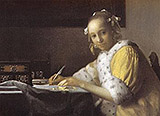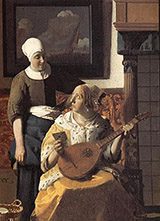Johannes Vermeer Oil Painting Reproductions
Johannes Vermeer replica paintings on Canvas for sale
Johannes Vermeer Painting: An Artistic Biography
Johannes Vermeer (also known as Jan Vermeer) was a leading Dutch Baroque artist. Despite his extreme fame and renown today, Vermeer was never a wealthy man. Nevertheless, he produced a few paintings during his life, working slowly with meticulous attention to detail.
But who was this enigmatic master of Baroque paintings? We explore Vermeer’s personal life and most famous paintings.
What type of artist was Jan Vermeer?
Jan Vermeer produced Baroque paintings in the late Dutch Golden Age. He is famous for his masterly treatment of color, lighting, and shadows. Indeed, Vermeer often used costly pigments despite his financial insecurity.
Information about Vermeer’s life is scant. Yet, despite this, we know some details about his life and family.
Baptized in the Reformed Church (a branch of Calvinist Protestantism) on 31 October 1632, Vermeer grew up in Delft, Holland. His father (Reijnier Janszoon) was a cloth merchant. Reijnier also started dealing with paintings around 1625, however. He leased a pub called the “flying fox” in 1631.
Vermeer’s father later moved to a larger pub on Delft’s market square named the “Mechelen.” The business was a considerable financial worry, however. So when Reijnier passed away (around 1652), Vermeer took over the pub and the family art business.
In 1653, Vermeer married a Catholic named Catharina Bolenes. It appears that, at the request of Catharina's mother (Maria Thins), Vermeer converted to the Catholic faith.
She objected to the marriage due to Vermeer’s poor finances and his father’s debts. However, after a recommendation from the Dutch Painter Leonaert Bramer, Maria dropped her opposition to the wedding.
Where did Johannes Vermeer live?
After the wedding, Catharina and Vermeer moved into Maria Thins’ substantial home at Oude Langendijk in Delft. Vermeer lived here for the rest of his life. He painted from the front room on the second floor.
The couple had fifteen children together. Sadly, four children died young. Nonetheless, historians know the names of 10 of Vermeer’s children from relatives' wills.
This includes Elisabeth, Cornelia, Maertge, Gertruyd, Aleydis, Catharina, Beatrix, Johannes, Franciscus and Ignatius. Reflecting Vermeer’s conversion to Catholicism, many names hold religious connotations.
In December 1653, Vermeer entered the Guild of Saint Luke. A prestigious association of painters, it heralded Vermeer’s local success and recognition.
Nonetheless, records show he didn’t pay the usual admission fee. In the Netherlands, 1653 was a challenging year. Many people (including Vermeer) experienced economic strife with plague, financial crisis, and war.
What are three interesting facts about Johannes Vermeer?
- Vermeer never attended art school. He was self-taught. Vermeer may have worked with the painter Carel Fabritius as an apprentice, but this is speculation. Most scholars believe Vermeer taught himself from paintings displayed at his father’s art business.
- Vermeer never traveled abroad. His paintings express his love of Delft, portraying city scenes and everyday people with astounding attention to detail.
- Most paintings by Vermeer use his mother-in-law’s house as the set. Indeed, in many of his paintings, the furniture is often rearranged in the background. His subjects are usually undertaking everyday activities, such as playing music, reading letters, or simply sitting at the kitchen table.
Why is Vermeer Famous?
If there’s one thing Jan Vermeer is best known for, it must be his Girl with a Pearl Earring 1665 oil painting; it is a work surrounded by mystery.
Known as the “Mona Lisa of the North,” the painting isn’t a portrait. Instead, it’s a “tronie,” a form of character study, not intended as a stand-alone artwork. Tronies (usually focus on close-up faces) help artists understand specific expressions and exaggerated costumes.
The girl’s luxurious turban in the portrait uses the finest lapis lazuli pigments. Scholars believe the girl’s earring isn’t a large pearl contributes more intriguing to the painting. Instead, many scholars think the material is tin due to its shape, size, and light reflection.
After 1657, Pieter van Ruijven supported Vermeer’s career. This financial backing allowed Vermeer to paint works such as the Girl with the Pearl Earring painting. However, we know Vermeer charged high prices for his paintings (over the typical average), probably due to the expensive pigments and time-consuming Baroque style.
In 1662, Vermeer became head of the Guild of Saint Luke. Re-elected in 1663, 1670, and 1671, it’s evidence of Vermeer’s growing reputation amongst his peers. Nonetheless, he only produced around three paintings yearly, primarily as commissions.
Why is the Girl with a Pearl Earring painting so famous?
Even amongst Vermeer paintings, Girl with a Pearl Earring is renowned for its beauty and skill. The sitter’s striking blue and yellow headscarf pops out against the dark background. Her “pearl” earring emerges with just a few expert brushstrokes.
As well as the reflection of light on her earring, light bounces from the girl’s slightly parted lips and her glinting eyes. Her luminous skin also shines out from the otherwise dark painting.
The young woman’s gaze is familiar yet uncertain. While we can see her face, it’s half turned away. Indeed, we don’t even know basics such as hair color. All these mysterious details explain the painting's ongoing fascination and fame.
Despite its iconic fame today, the painting sat in obscurity for centuries. It remained with Vermeer’s patron (Pieter van Ruijven) before his son-in-law sold it after his death. Girl with Pearl Earring only resurfaced around 200 years later when a collector bought the work for two guilders (less than $1).
He only discovered it was Vermeer after cleaning the painting. After this collector’s death, the painting passed to the Mauritshuis Museum in the Hague. It’s remained on display in the gallery ever since.
What are Vermeer's most famous three paintings?
In addition to Girl with a Pearl Earring, three other famous paintings by Vermeer include:
- The Little Street (c.1657) – held by the Rijksmuseum of Amsterdam, it’s a small painting depicting an everyday street scene. Alongside works such as View of Delft, it shows Vermeer’s deep appreciation of his home city.
- The Milkmaid (1658) – also known as The Kitchen Maid, depicts a woman in a domestic setting pouring milk. Also displayed at the Rijksmuseum, it is one of the museum’s “finest attractions.” The painting masterfully conveys a sense of weight, light, and dark. Indeed, the bread is so wonderfully textured that it is ready to be picked from the canvas.
- A Woman Holding a Balance (c.1662) – another of Vermeer’s indoor portraits, it’s displayed at the National Gallery of Art in Washington, DC. While many thought the pregnant woman weighed gold, the balance was empty. She could represent a mix of spiritual judgment and earthy concerns. Indeed, the Last Judgment painting (immediately behind) adds to this interpretation.
How Many Vermeer Paintings Exist?
Today, around 34 Johannes Vermeer paintings remain in existence. Although, Scholars believe he produced around 50 paintings during his lifetime.
In 1672, another catastrophe faced the Netherlands. Known as the “Year of Disaster,” the country faced an extreme economic downturn with multiple foreign invasions. In the resulting panic and confusion, the art market collapsed. Vermeer didn’t sell another painting after this date.
In 1674, Vermeer enrolled as a member of the Delft voluntary city guards. The following year, he borrowed 1,000 guilders from an Amsterdam silk trader, using his mother-in-law’s substantial house as surety. Johannes Vermeer expected to pay it back, but he died unexpectedly on 15 December 1675.
He left his wife and their eleven children in debt. Catharina pleaded with his creditors. She wrote how Vermeer was “unable to sell any of his art.” Owing to this financial “great burden,” she described how he fell into a “frenzy” and, within a day and a half, went from “healthy to dead.”
Is Girl With the Pearl Earring a true story?
In 1999, an American author, Tracy Chevalier, published a Vermeer book inspired by the Pearl Earring painting. While reflecting some historical truth, it is a fictional account of Jan Vermeer and the enigmatic girl in the painting.
It’s also the subject of a 2003 film (also titled Girl with a Pearl Earring) starring Scarlett Johansson. It is an adaptation of the Vermeer book and a fictionalized movie of his life and oil paintings.
Named “Griet” in the film, the girl works as Vermeer’s maid after her father goes blind. In the movie, Vermeer becomes incredibly fond of Griet, discussing art and painterly techniques with her. Seeing the young beauty, Vermeer’s patron asks if she can work for him. Vermeer politely refuses, offering to paint her picture for him instead.
Unfortunately, there is no evidence for these stories. The sitter’s real identity and why Vermeer painted the work are unknown.
Johannes Vermeer artworks: Fine art oil paintings
If you love the unparalleled beauty of paintings by Vermeer, enjoy discovering our extensive art collection of museum-quality oil paintings on canvas. Buy fine art reproductions of the most famous Baroque paintings.
Cannot Find What You Are Looking For?
Reproduction Gallery Information
Customer Service
(Send Us A Message)
Tel: (503) 937 2010
Fax: (503) 937 2011



















